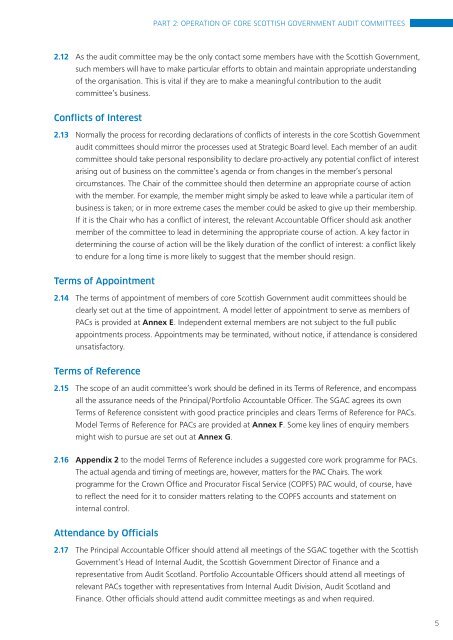Audit Committee Handbook - Scottish Government
Audit Committee Handbook - Scottish Government
Audit Committee Handbook - Scottish Government
You also want an ePaper? Increase the reach of your titles
YUMPU automatically turns print PDFs into web optimized ePapers that Google loves.
PART 2: OPERATION OF CORE SCOTTISH GOVERNMENT AUDIT COMMITTEES<br />
2.12 As the audit committee may be the only contact some members have with the <strong>Scottish</strong> <strong>Government</strong>,<br />
such members will have to make particular efforts to obtain and maintain appropriate understanding<br />
of the organisation. This is vital if they are to make a meaningful contribution to the audit<br />
committee’s business.<br />
Conflicts of Interest<br />
2.13 Normally the process for recording declarations of conflicts of interests in the core <strong>Scottish</strong> <strong>Government</strong><br />
audit committees should mirror the processes used at Strategic Board level. Each member of an audit<br />
committee should take personal responsibility to declare pro-actively any potential conflict of interest<br />
arising out of business on the committee’s agenda or from changes in the member’s personal<br />
circumstances. The Chair of the committee should then determine an appropriate course of action<br />
with the member. For example, the member might simply be asked to leave while a particular item of<br />
business is taken; or in more extreme cases the member could be asked to give up their membership.<br />
If it is the Chair who has a conflict of interest, the relevant Accountable Officer should ask another<br />
member of the committee to lead in determining the appropriate course of action. A key factor in<br />
determining the course of action will be the likely duration of the conflict of interest: a conflict likely<br />
to endure for a long time is more likely to suggest that the member should resign.<br />
Terms of Appointment<br />
2.14 The terms of appointment of members of core <strong>Scottish</strong> <strong>Government</strong> audit committees should be<br />
clearly set out at the time of appointment. A model letter of appointment to serve as members of<br />
PACs is provided at Annex E. Independent external members are not subject to the full public<br />
appointments process. Appointments may be terminated, without notice, if attendance is considered<br />
unsatisfactory.<br />
Terms of Reference<br />
2.15 The scope of an audit committee’s work should be defined in its Terms of Reference, and encompass<br />
all the assurance needs of the Principal/Portfolio Accountable Officer. The SGAC agrees its own<br />
Terms of Reference consistent with good practice principles and clears Terms of Reference for PACs.<br />
Model Terms of Reference for PACs are provided at Annex F. Some key lines of enquiry members<br />
might wish to pursue are set out at Annex G.<br />
2.16 Appendix 2 to the model Terms of Reference includes a suggested core work programme for PACs.<br />
The actual agenda and timing of meetings are, however, matters for the PAC Chairs. The work<br />
programme for the Crown Office and Procurator Fiscal Service (COPFS) PAC would, of course, have<br />
to reflect the need for it to consider matters relating to the COPFS accounts and statement on<br />
internal control.<br />
Attendance by Officials<br />
2.17 The Principal Accountable Officer should attend all meetings of the SGAC together with the <strong>Scottish</strong><br />
<strong>Government</strong>’s Head of Internal <strong>Audit</strong>, the <strong>Scottish</strong> <strong>Government</strong> Director of Finance and a<br />
representative from <strong>Audit</strong> Scotland. Portfolio Accountable Officers should attend all meetings of<br />
relevant PACs together with representatives from Internal <strong>Audit</strong> Division, <strong>Audit</strong> Scotland and<br />
Finance. Other officials should attend audit committee meetings as and when required.<br />
5

















